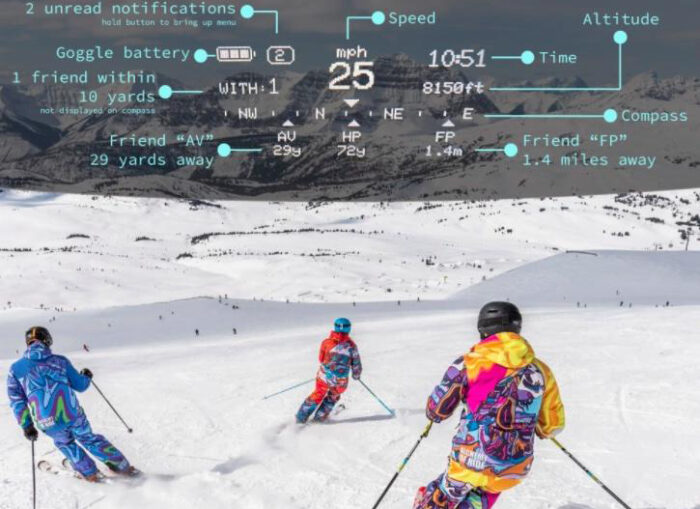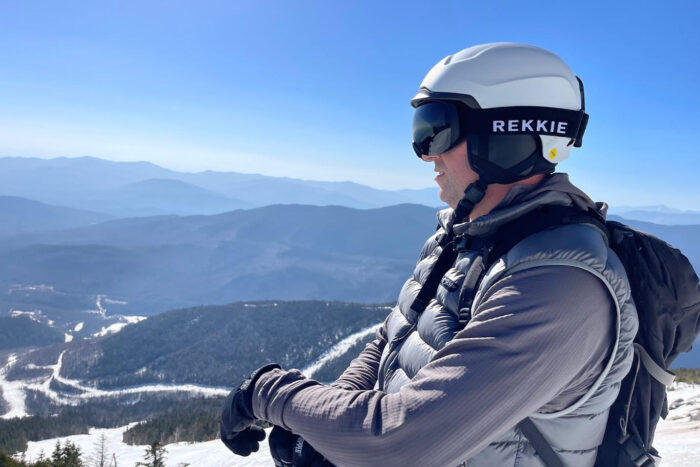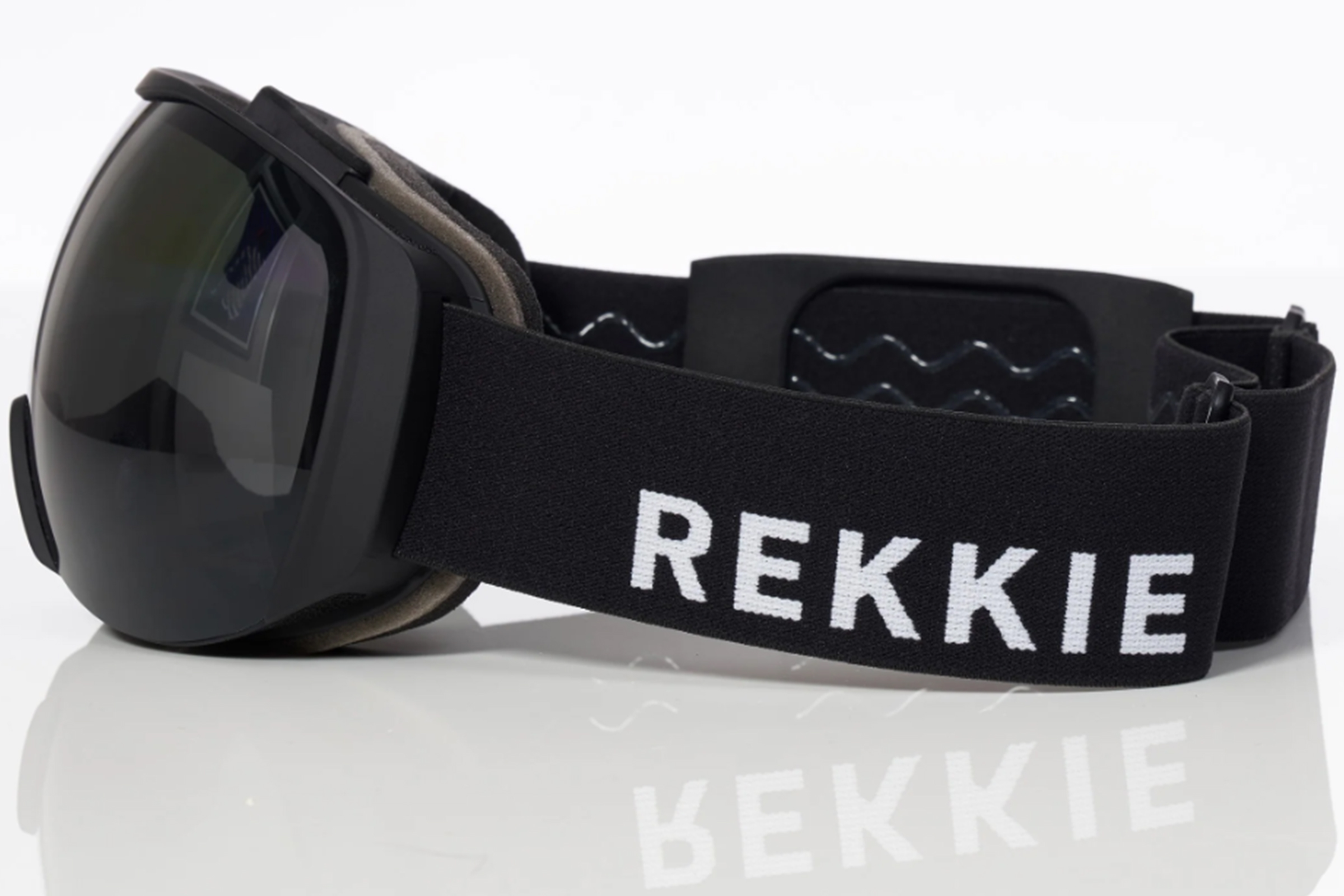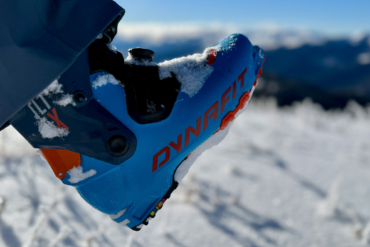I usually scroll past most social media advertisements. But when an outdoor brand mentions the video game Halo, my inner nerd gets hooked. Which was exactly what drew my attention to the Rekkie smart goggles. Rekkie claimed to have incorporated a Heads Up Display (HUD) similar to that of Halo’s main character, Masterchief, into its new smart ski goggles.
My interest was more than piqued. As a former Apache pilot, I’d flown with similar technology. So I wanted to assess its viability and potential applications for both in-bounds skiing and backcountry excursions.
Rekkie is an independent company based in Ohio. The brand’s entrepreneurs wanted an efficient solution to mitigate time spent linking up with friends or tracking each other in off-piste terrain. They accomplished this by integrating augmented reality (AR) into premium-quality ski goggles displaying all kinds of relevant data. Simply put, Rekkie is trying to enhance reality with digital information.
Testing these at Whiteface Mountain in upstate New York with spectacular spring conditions was incredible. After countless runs, inadvertent durability checks (sometimes you have to go full send), and some solid goggle tan lines, I’m enthusiastic about these goggles.
In short: Premium goggles can exceed $300, but none offer the patent-pending capabilities that Rekkie Smart Snow Goggles leverage through technology and at a competitive price of $350. The technology was intuitive, the functions were useful, and the product delivered on Rekkie’s promises. Despite small drawbacks (like the display being hard to read on the brightest days, and batteries only lasting a few hours), these goggles are a slick option for skiers and riders who want information and data at their fingertips on the slopes.
- Weight: 9 oz.
- Lens: Spherical gray lens, 23% VLT (visual light transmission)
- Battery life: 10-15 hrs.
- Connectivity: iPhone and Android compatible via Bluetooth utilizing GPS and cellular data
- 915 MHz radio transceiver for direct goggle-to-goggle networking:
Rekkie Smart Snow Goggles Review
The Goggles
Ski optics have not conceptually changed since 1965 when Dr. Bob Smith invented the double lens. The recipe is similar to Smith, Oakley, and Rekkie’s current designs. Rekkie uses quality materials to construct the interchangeable dual lenses housed in an injection-molded frame with a helmet-compatible nonslip strap.
The divergence occurs with state-of-the-art 3D manufacturing. 3D Printing produces the nylon-constructed pack that houses the electronic components, power supply, and HUD mount attached to the Rekkie lens frame.
Despite manufacturing complexities, the user interface is simple. Rekkie’s design permits the wearer to access different information by pressing the glove-compatible button on the electronic housing.

HUD Dashboard
Without getting too deep in the weeds, the HUD is impressive. Rekkie displays the digital information above your line of sight without inhibiting your field of view. The app lets you control the HUD brightness based on ambient light conditions.
The primary information displayed on the dashboard includes time, compass, notifications, ground speed (mph), elevation, and group information. The compass is a 160-degree arc that rotates as you move.
If you have a group set up with Rekkie app users, you’ll get cueing with their name, displaying their bearing and range relative to your position. This feature is immediately applicable to large resorts but also in the backcountry. I found this helpful when my friend decided to cut through some glades as I navigated the trail back to the lift. It was a cinch to find them.
And contrary to what some might expect, the HUD was never an annoyance and never obscured my field of vision. Most of the time while I was skiing, I pretty much saw straight through it.
For backcountry applications with little to no cell service, the 915MHz transceiver gives you the same cueing, but all members in the group must have the goggles for connectivity. Note: This product is not a substitute for an avalanche beacon.
Accessing other information, such as your music, notifications, and daily stats (vertical feet traversed and top speed), is intuitive. Depress the button, and look in the direction (up, down, left, or right) of the information you wish to choose. This action selects that info. Once set, release the button and the selected information will remain on display.
Other goggle manufacturers have attempted to integrate computer displays into snow goggles before. But this is one of the most seamless and functional designs so far. And it’s only Rekkie’s first iteration.

Battery Charge and Power
Powering the goggles is a lithium polymer battery utilizing a USB-C charger. Achieving a full charge takes 3-4 hours. But skiing in mild temps and using them for about 6-8 hours a day, the charge times didn’t exceed 2 hours.
Below-freezing temperatures will almost certainly impact battery longevity. That might not be too big of an issue for warmer spring days but could be problematic on the mountain during the colder months.
The App
The features of the app are straightforward. You set up your profile and connect your goggles. You can create a group for tracking friends. Once the invite is sent and accepted, their location is depicted on the Google Maps feature of the app.
Where It Falls Short
On the brightest bluebird days, the HUD doesn’t have enough brightness with the current lenses. Rekkie plans on offering a solution to this during the 2023/24 season.
Also, a USB-C port powers the onboard battery and while I love this selection, the port isn’t protected from the elements. Despite being exposed after days of spring skiing, I experienced no issues. But it’s a vulnerability that caught my attention.
Rekkie Smart Goggles: Conclusion

Overall, I’m impressed with the quality, fit, and function of the Rekkie Smart Goggles. The intuitive design offers the user a premium experience, and modern manufacturing and technology make these futuristic ski goggles competitively priced.
Rekkie’s ski goggles won’t appeal to everyone, but this technology is far less niche than I initially gave it credit for. It has useful applications in bounds on the resort as well as out of bounds in the backcountry.
With trips to the backcountry of the White Mountains and the San Juans in the works this season, I’m excited to get more time with these goggles in the field.









